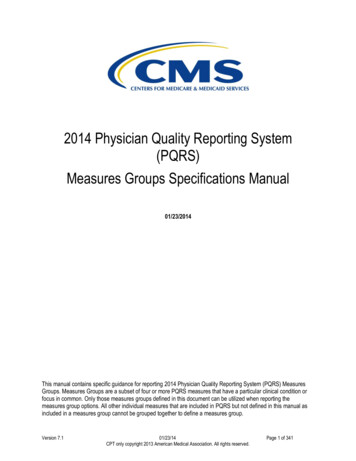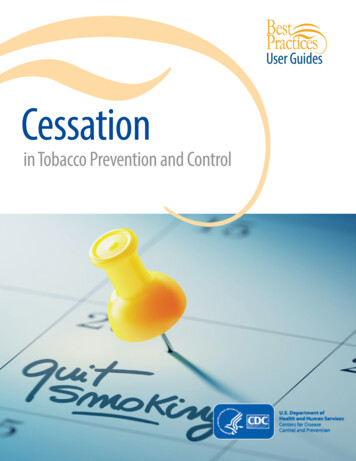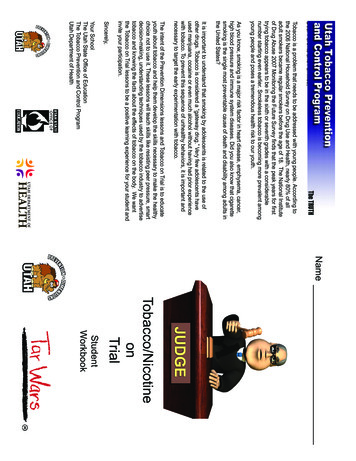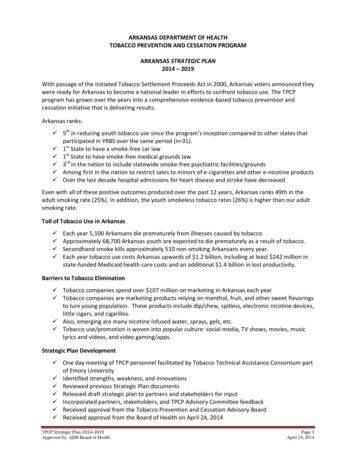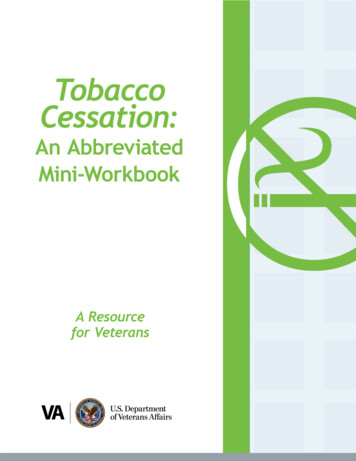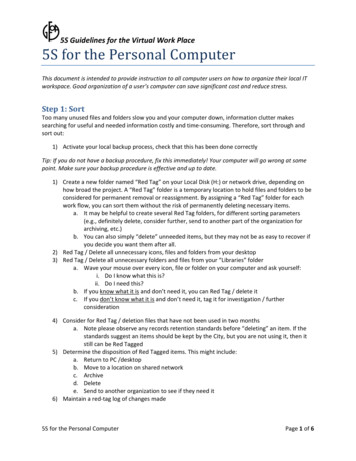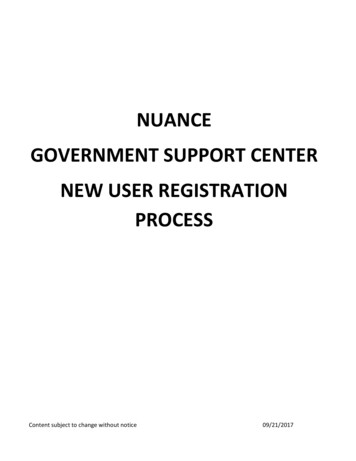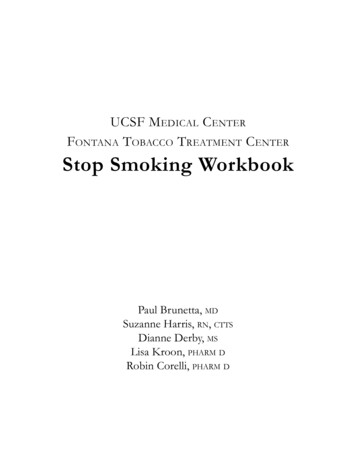
Transcription
UCSF Medical CenterFontana Tobacco Treatment CenterStop Smoking WorkbookPaul Brunetta, mdSuzanne Harris, rn, cttsDianne Derby, msLisa Kroon, pharm dRobin Corelli, pharm dStop Smoking Workbook1
1999–2012 The Regents of the University of California. All rights reserved.CreditsNeal Benowitz, md:Neurochemical and Related Effects of Nicotine, page 54Paul Brunetta, md:Small-Cell Lung Cancer, pages 82–84True Emotions, pages 88–92Smoking Cessation: Advice to Clinicians and Patients, pages 97–101Karl Fagerström:, phdFagerström Scale, page 25John Harding photographs:Clarence Brown, page 10Roger Sako, page 80Barbara Vos, page 86Suzanne Harris, rn, ctts:Clarence Brown, page 11Roger Sako, pages 81, 82Barbara Vos, pages 87, 88
ContentsAbout This Workbook. 6.Lesson One. 9Clarence Brown. 10Lung Health. 12Tobacco-Related Disease. 13What’s in Cigarette Smoke?. 16Tobacco Facts. 17Carbon Monoxide. 18The Power of Denial. 19What Is Motivation?. 20My “Want to” Motivation. 22Smoking Behavior Awareness. 23Rating Your Addiction to Nicotine: Fagerström Questionnaire. 25Setting Your Stop Date. 26Practice and Exercises. 27Sample from a Smoking Journal. 28Smoking Awareness Journal. 29Lesson Two. 31Medicines for Smoking Cessation. 32Readiness for Change. 42Introduction to the Journey of Change . 43The Journey of Change. 44Courage Desire Doubt Action. 45Practice and Exercises. 46Smoking Awareness Journal. 47Lesson Three. 50Understanding Dependence. 51Nicotine Addiction Cycle. 52Withdrawal Symptoms. 53.Neurochemical and Related Effects of Nicotine. 54
Understanding the Thought Process. 55Using Language. 58Trying. 59“Entitlement”—Another Language Trap. 60Triggers. 60Commit to Quit Agreement. 61Quit Date Tips. 62Dealing With Urges. 63Rewards and Celebrations. 64My Quit Plan. 65Practice and Exercises. 67Smoking Awareness Journal. 69Lesson Four. 72Benefits of Quitting . 73Preventing Relapse. 74Setting New Goals. 75Quit Bonus Calculation. 76Practice and Exercises. 77Smoking Awareness Journal. 78Roger Sako.81Small-Cell Lung Cancer.82Barbara Vos.87True Emotions.88Breathing, Smoking, and the Stress Response.94Breathing Exercises.96Smoking Cessation: Advice for Clinicians and Patients.97About the Fontana Tobacco Treatment Center (FTTC).102Biographies.104Resources.105Course Evaluation and Feedback.1064Stop Smoking Workbook
For a smoker,quitting smokingis the single most important thingyou’ll ever do for your health.Stop Smoking Workbook5
About This WorkbookYou may be reading this introduction as a member of one of our Stop SmokingGroups. Perhaps you are considering using this workbook to assist you in overcomingsmoking on your own. Or you may be a nonsmoker seeking information about tobaccodependence and how you could support a friend or loved one who is trying to achievefreedom from smoking. Regardless of your motivation, we hope you will find contentin this workbook that will be of use to you.The Fontana Tobacco Treatment Center (FTTC) at the UCSF Medical Center wasfounded by a physician and a nurse who are former smokers and have witnessed immensely debilitating effects of prolonged tobacco use. Recognizing that stopping smoking is the single most important thing a smoker can do to improve health, they createdthe FTTC as a resource for smokers and their friends and family, and also for medicalpersonnel. The FTTC offers group and individual support for smokers, and it serves asan educational resource for health-care providers and the public.This workbook is structured into four weekly lessons. Because each lesson builds onthe previous ones, the sequence is important. Information in each lesson is organizedinto three sections: medical implications of tobacco dependence, understanding andbuilding motivation, and planning skills to help you reach your goals. Weekly homeworkconcludes each lesson. We suggest setting a stop smoking date between the third andfourth weeks.If you are a smoker, quitting smoking will be the most important thing you ever dofor your overall health. It probably won’t be easy—and you may experience bothersome withdrawal symptoms as your brain tries to fool you into smoking again. Thereis no easy way to do this—no magic tricks beyond getting focused and doing the work.Sometimes a person finds that stopping seems easier than expected, and then twomonths later he or she has a drink, is handed a cigarette, and thinks, It’s OK. I was ableto quit before, I can smoke just one.The important thing is to persevere. Tobacco dependence is a powerful disease, onethat millions of smokers have overcome with profound benefits to their health, qualityof life, and peace of mind. Congratulations for making the important decision to embark on this journey. Keep putting one foot in front of the other and you will arrive atyour destination: a smoke-free life.6Stop Smoking Workbook
ObjectivesUpon completion of this course, you will Become aware of your tobacco use patterns Understand biochemical and physiologic effects of tobacco use Understand components of addiction Learn to self-motivate Acquire practical stress management skills Develop a plan to overcome tobacco use Recognize risks for relapse Overcome a relapse if it occurs Move from intention to action Live your plan and become tobacco freeIntroductions Your name How much are you smoking now? When did you start smoking? Why? Have you ever tried to stop before? When was the last time? What were the results? What are some of your reasons for choosing to stop smoking now? On a scale of 0 to 10, where 0 is ‘not at all confident’ and 10 is ‘extremely confident”how would you rate your confidence in your ability to stop for good?Notes:Stop Smoking Workbook7
FTTC Stop Smoking ionSMOKE FREE8Stop Smoking Workbook
Lesson OneMedical Lung health Tobacco-related disease What’s in cigarette smoke Tobacco facts Carbon monoxideMotivation Motivation defined Fear vs. desire My “want to” motivation Power of denialPlanning Smoking behavior awareness Rating your addiction to nicotine Your denial story Setting your stop dateStop Smoking Workbook9
In the photograph of Clarence, the medical records on the right are from the fiveyears before he stopped smoking; the records on the left are from the five years afterhe stopped. Even for someone who has smoked for years and has serious medicalproblems, the improvements in quality of life and health associated with becomingsmoke free can be dramatic.10Stop Smoking Workbook
Clarence BrownHello, my name is Clarence. I was a smoker for 33 years. I had my first cigarette when I was 11 years old. It made me sick and I thought I was going todie. I smoked again when I was 18 years old. When I started smoking it wasthe cool thing to do and I smoked to be part of the group. As I became older, smokingbecame a way of life. I had a cigarette when I was thinking things over, when I neededto relax, with coffee, and with meals. I felt that smoking made me smarter.When the bad news about cigarettes and health started coming out, I thought that itwouldn’t affect me; I kept smoking. When my nurse warned me about cigarettes’ hazards on my health, I thought that it wouldn’t happen to me; I kept smoking.In 1983, I was intubated for the first time. Since I was unable to breathe for myself, atube was put down my throat and into my lungs. Oxygen was pushed through this tubeby a machine. I couldn’t talk because a tube was down my throat; it was terrible.I remember being trapped in this hospital bed with all kinds of tubes going in andout of me. My only thoughts were about when I could get out of bed and push my IVto the patio and have a cigarette. This same story gets repeated seven times. I’d be inthe hospital, intubated, and turn around and continue the same habits that got me therein the first place.In 1986, I tried to quit for the first time. I went to one group, then dropped theprogram. It took three more tries, but on March 23, 1991, I quit smoking for good. Itwasn’t easy. I had abused cocaine, heroin, and marijuana. I quit them all, but nothingwas as hard as cigarettes.As I attended the groups and began to view myself as a nonsmoker, I began to notice some changes in my physical health. I was able to walk farther without having tostop and catch my breath. I’d recuperate faster at home without having to come to thehospital. In 1993, for the first time in years, I went a whole year without being hospitalized once!Believe me, I know it is hard to quit, but you CAN. It’s your life. I know how themind can run things. Always making excuses for smoking, not taking care of yourhealth or the health of the people around you. The biggest barrier you have to face isyour mental attitude. That you have to change.I know my life is much better as a nonsmoker. My health is better. Even my friendsand family tell me that they see that things are going better for me.I used to think, Why should I quit? I enjoy cigarettes. Now as I look back on mysmoking, I didn’t enjoy them. I say to people, “Sure, you tell me you want to quit, butwhat are you going to DO to quit smoking?”Stop Smoking Workbook11
Lung HealthLike any other part of the body, the lungs have a natural progression of aging. Smokingtends to accelerate that aging as well as create debilitating disease.This graph illustrates the natural history of airflow obstruction, a marker for lungdegeneration. The vertical axis shows the amount of air that can be exhaled during thefirst second of forceful expiration (FEV1). The horizontal axis measures age in years.A person who never smokes begins a slow decline of lung function starting at aboutage 60. A smoker who smokes regularly can expect acceleration of that decline, perhapsleading to disability or early death. Even after 25 or more years of smoking, stoppingcan bring the rate of decline back to normal.When Clarence Brown became smoke free in 1991, he was already disabled withsevere chronic obstructive pulmonary disease (COPD). Had he not stopped when hedid, in all likelihood he could have died within a year. As it was, quitting smoking gavehim 11 more years of quality life, until he died in 2002.Beneficial Effects of Quitting:Pulmonary EffectsAt any age, there are benefits of quitting.COPD chronic obstructive pulmonary diseaseFletcher & Peto. Br Med J 1977; 16077):1645-1648. Reproduced/amended with pemmission from the BMJPublishing Group.12Stop Smoking Workbook
Tobacco-Related Disease“Cigarette smoking is the chief, single, avoidable cause of death in our societyand the most important public health issue of our time.”—C. Everett Koop, M.D., former U.S. Surgeon General, 1982Cigarette smoke is made up of a complex mixture of hot gases and particles. Whensmoke is inhaled, the gases harm the cilia, which are the small hairs lining the airwaysthat help the lungs to remove dirt.The larger particles (tar) in smoke collect at the branching points in the lungs andincrease a smoker’s risk of lung cancer.The smaller particles collect in the small air sacs in the lung. They damage the airsacs and from this site are carried to other parts of the body where they can cause diseases.The main health risks from tobacco smoke include the following:CANCERSCARDIOVASCULAR DISEASES Lung Laryngeal, pharyngeal, oral cavity,esophageal Pancreatic Bladder and kidney Cervical Gastric Acute myeloid leukemia Abdominal aortic aneurysm Coronary heart disease (angina pectoris,ischemic heart disease, myocardialinfarction) Peripheral arterial disease Cerebrovascular disease (transient ischemicattacks, strokes)CStop Smoking Workbook13
PULMONARY DISEASES Acute respiratory illnesses Upper respiratory tract (rhinitis,sinusititis, laryngitis, pharyngitis) Lower respiratory tract (bronchitis,pneumonia) Chronic respiratory illnesses Chronic obstructive pulmonary disease Respiratory symptoms Poor asthma control Reduced lung function14REPRODUCTIVE EFFECTS Reduced fertility in women; increasedoccurrence of impotence and spermabnormalitities in men Carbon monoxide and carcinogenstransferred to the baby by a smokingmother cause a 30% increase in birthdefects, stillbirth, and spontaneousabortion. Low infant birth weight Sudden infant death syndromeOTHER EFFECTS Cataract Osteoporosis (reduced bone density inpostmenopausal women, increased riskfor hip fracture) Periodontitis Peptic ulcer disease (in patients who areinfected with Heliobacter pylori) Surgical outcomes Poor wound healing Respiratory complicationsStop Smoking Workbook
Smoking speeds up the aging process, andthe risk of dying from diseases of oldage shifts to younger ages. Smoking causes the restriction of bloodvessels which raises blood pressure andspeeds aging of the skin, causing facialwrinkling.U.S. Department of Health and Human Services. The health consequences of smoking: a report of the SurgeonGeneral. Bethesda (MD); U.S. Department of Health and Human Services, Centers for Disease Control andPrevention, National Center for Chronic Disease Prevention and Health Promotion, Office on Smoking andHealth; 2004)Stop Smoking Workbook15
What’s in Cigarette Smoke?A burning cigarette is a small chemical factory that producesmore than 4,000 chemicals, including over 60 known or suspected carcinogens.Some of the chemicals are.Cancer-Causing onium 210NickelPolycyclic aromatichydrocarbonsDibenz acidineB-NapthylamineUrethaneN. nitrosonornicotineToluidineMetalsOther reneMethyl ethyl ketoneMany of the chemicals found in cigarette smoke also have other uses AcetoneNail polish removerAcetic acidVinegarAmmoniaFloor/toilet cleanerArsenicRat poisonButaneLighter fluidCadmiumRechargeable batteriesCarbon monoxideCar exhaust fumes16Stop Smoking ldehydeBody tissue preservativeHexamineBarbecue lighterHydrogen cyanideGas chamber poisonMethaneSwamp gasMethanolRocket zeneGasoline additiveNitrous oxide phenolsDisinfectantStearic acidCandle waxTolueneIndustrial solventVinyl chlorideMakes polyvinylcholoride (pvc)
Tobacco FactsTotal deaths fires, crack, suicide,morphine, car accidents, AIDS,cocaine, homicide, alcohol, andheroin TOTAL DEATHSPortion of U.S. DeathsAttributable to SmokingLung cancer90%Emphysema and bronchitis 85%Mouth cancer 70%Throat cancer 50%Bladder cancer 50%Esophagus cancer40%Pancreas cancer35%5-Year Survival Rates forSelected CancersLung 12%Colon 57%Cervix 68%Breast 78%Prostate 93%tobaccoTOTAL DEATHSEVERY YEARThe majority of lung cancers are smokingrelated, and lung cancer has the lowestsurvival rate of the cancers listed here. Tobacco use is the leading cause of preventable disease, disability, and death in theUnited States.Nicotine is at least as addictive as cocaine or heroin and may even be more addictivethan these drugs.Medical care for smoking-related illnesses in the United States costs about 50 billionannually.Prior to 1900, only 134 cases of lung cancer had ever been reported in the world’smedical literature.In the early 1900s, cigarettes began to be mass produced and mass marketed.Lung cancer is now the most common malignancy in the world.In 1987, lung cancer overtook breast cancer as the most common cancer in women.Children of smokers have more asthma, more respiratory and ear infections, and ahigher risk of lung cancer later in life.Stop Smoking Workbook17
Smoking triples the chances of having a heart attack.Risk of coronary heart disease is 70% higher among smokers.Smoking causes 85% of all chronic obstructive pulmonary disease (COPD) andemphysema deaths.Approximately 3,000 nonsmokers die each year from lung cancer due to second-handsmoke exposure.More than 35,000 nonsmokers die each year from heart disease due to second-handsmoke exposure.Cigarettes are the only products allowed on the market that, if used as intended, willkill half or more of its users.More than 3,000 American children and teenagers become smokers each day.Tobacco companies need to recruit approximately 5,000 new smokers everyday simply to maintain their sales in the United States. (Killing off your regularcustomers creates a lot of work!)Carbon MonoxideCarbon monoxide (CO) is a dangerous gas that is tasteless and odorless. It is produced withany combustion or fire. Therefore, when a smoker takes a drag on a cigarette, he or she istaking in carbon monoxide. In sufficient amounts, carbon monoxide can kill you.Carbon monoxide has a negative effect on your body’s ability to function properly. Yourblood is red because it contains billions of red blood cells that carry a molecule called hemoglobin. Hemoglobin has a vitally important job: to bind to oxygen. Your red blood cells pickup oxygen in your lungs and then deliver it to all of the cells in your body, which allows themto function normally. All of the cells in your body must have oxygen to survive without it,they will die in minutes.Carbon monoxide is so dangerous because it binds to hemoglobin 200 times tighter thanoxygen, in essence, pushing the oxygen aside. As a result, oxygen does not get delivered properly, and your body’s cells and organs have to struggle to function at all.The more you smoke, the higher your CO level will be.A normal CO level is less than 6 parts per million (ppm).Within days of stopping smoking, your CO level will return to normal.Your CO level at the start of the program is ppm.18Stop Smoking Workbook
The Power of DenialIn 1995 a telephone survey of smokers was conducted Only 29% think that they have an increased risk of cardiac infarction. Only 40% think that they have an increased risk of cancer.(Ayanian, C. Jama 1999; 281: 1019.)DENIAL:the stories we tell ourselves to make it okay to keep smoking.Some familiar denial stories.My grandmother smoked two packs per day and she lived to be 102.I’m going to die of something.why not continue to enjoy smoking?I had a chest X-ray a couple of years ago, and my doctor said it looked great.My life is too stressful. I have to smoke.I only smoke two cigarettes a day or on the weekends or low-tar cigarettes.I can’t do my taxes without smoking.It’s my right to smoke. It is no one’s business what I do.My sister got cancer and she never smoked, so why not smoke?If I quit smoking, I’ll gain 50 pounds.I need to smoke to concentrate on my writing.I don’t believe that smoking causes diseases could be a poor diet or just bad luck.I don’t smoke as much as I used to.I’m going to quit when I’m 30 or 40 or 50.What’s your personal denial story?Write it down.Notice how resistant you are to writing your story. Writing it can decrease the powerit has to keep you stuck.Stop Smoking Workbook19
What Is Motivation?It is simple really MOTIVATION ENERGYYou notice that things are not how you expect them to be not how they “should be” outside what you are comfortable withiEnergy turns oniTake action to get back on trackiEnergy turns offIt doesn’t matter if the “should be” is better for us or worse for us Sink overflows?Win the lottery?Lose weight?Fix it!Spend it!Gain it!Back to the couch.Back to work.Back to familiar clothes.The trick is knowing how and choosing to motivate ourselves on purposeto accomplish the things we want.What “should be’s” or comfort zones keep you from getting what you want?20Stop Smoking Workbook
MotivationFEAR DESIREA gun A carrotRestricts behavior Encourages actionAvoid something Achieve something“I have to ”i“I want to ”iLeads to feeling Leads to feeling Resistant Weak Powerless Worthless Hopeless Stuck Confident Strong Empowered Self-esteem Hopeful You have choicesOne Positive Note:The Most Important Point:Helps combat denialHelps create lasting changeStop Smoking Workbook21
My “Want to” MotivationTo become and stay smoke free, it is helpful to focus on your desire-based reasonsfor stopping. Why do you want to stop rather than why do you have to stop. In otherwords what positive things will being smoke free give you? List as many reasonsfor stopping as you can.big reasons and small ones. Once you have your list, youmay want to place a star beside the reasons that seem particularly important to you.I want toI want toI want toI want toI want toI want toI want toI want toI want toI want toI want toI want toI want toI want to22Stop Smoking Workbook
Smoking Behavior AwarenessMany smokers report that they often smoke without even thinking about it. It is just anautomatic habit. Therefore, an important step in the quitting process is to understandyour unique relationship to cigarettes. Quitting can be made easier if you know what youare up against. It may take you a while to figure it all out stick with it!DependenceFour basic components work in combination to reinforce smoking behavior and create dependence. On a scale of 1 to 10, rate how strong each component is for you.Hand-to-mouth stimulationphysical act of smoking: holding the cigarette, putting it in your mouth,striking the match, flicking the ashes, etc. You can try using other objectslike tooth picks, cinnamon sticks, chewing gum, licorice root, and the like tosatisfy hand and mouth cravings.NicotineEmotional and psychologicalDeep breathingThis component includes all of the habits and behaviors associated with theNicotine is among the most addictive substances known to humankind. If youget strong cravings to smoke and feel desperate for it, you are probably havingnicotine withdrawal and you may be a good candidate for nicotine replacementtherapy.Have cigarettes been helping you deal with life by reducing your responsesto your environment? Smokers often use cigarettes to push down difficultemotions or to deal with unpleasant situations. Cigarettes can become asmoker’s main coping strategy for stress. Choosing to be smoke free offers theopportunity to gain new coping skills.This component is not as obvious as the others; however, one reason peoplesmoke is that it allows them to take a deep breath. Deep abdominal breathingitself is relaxing, without the smoke! Many smokers have forgotten how to usetheir breath for relaxation. Taking deep breaths several times a day is an easyand effective way to combat cravings.Stop Smoking Workbook23
Smoking Behavior Awareness (cont.)EnvironmentIt is also helpful to understand how your environment is set up to support yourtobacco use. Without even realizing it, you have developed certain ways of living thatallow you to continue using tobacco. People who are addicted to nicotine protect theirsupply in much the same way that alcoholics keep close track of where they will gettheir next drink. You might be surprised at how much of your life is arranged aroundyour tobacco use. These automatic, unconscious “arrangements” are the behaviorsthat support your addiction and make it possible for you to continue using tobacco.So think about the arrangements you have made to make smoking a convenientoption: Where do you purchase your cigarettes? How much do you purchase at once? Where do you keep your supply? How many lighters do you have? Do you collect matches when you are out and about? Where are all of your ashtrays located? Where do you allow yourself to smoke? Who are all the people that you smoke with? Friends? Family? Coworkers? Do you seek out other smokers? How often are you in smoke-free social situations? Do you avoid them? What is your reaction when you are forced into smoke-free places? Malls?Restaurants? Airplanes?To better understand your unique relationship with tobacco, we encourage you tokeep a daily Smoking Awareness Journal, which is located at the end of each section inyour workbook.Knowledge is power!24Stop Smoking Workbook
Rating Your Addiction to Nicotine:Fagerström QuestionnaireAnswer each question by checking the box that best applies to you. At the end you willtotal your points to find out how addicted you are to nicotine.1.How soon after you wake up do you smoke your first ci
program. It took three more tries, but on March 23, 1991, I quit smoking for good. It wasn’t easy. I had abused cocaine, heroin, and marijuana. I quit them all, but nothing was as hard as cigarettes. As I attended the groups and began to view myself as a nonsmoke
